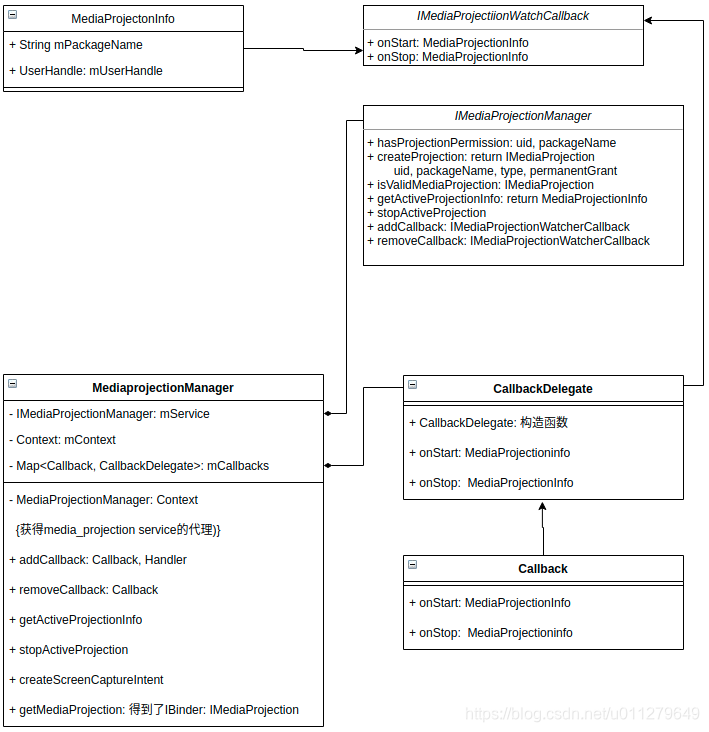MediaProjection是什么
MediaProjection指的是一个令牌,这个令牌授权应用一个能力:去捕捉屏幕内容和系统声音
* A token granting applications the ability to capture screen contents and/or
* record system audio. The exact capabilities granted depend on the type of
* MediaProjection.
MediaProjection本身并没有太多关于audio/vedio的操作,主要功能是个授权。
MediaProjectionManager:管理MediaProjection令牌的创建等
Manages the retrieval of certain types of MediaProjection tokens.
Client 侧代码
SystemService怎样和Client 关联的
SystemService怎样和Client 关联的, getSystemService的返回值怎么就是MediaProjection? MediaProjection并没有实现IMediaProjectonManger接口啊。
MediaProjectionManager mProjectionManager = (MediaProjectionManager) getSystemService(Context.MEDIA_PROJECTION_SERVICE);在SystemServiceRegistry.java中进行了关联
frameworks/base/core/java/android/app/SystemServiceRegistry.java
registerService(Context.MEDIA_PROJECTION_SERVICE, MediaProjectionManager.class,
new CachedServiceFetcher<MediaProjectionManager>() {
@Override
public MediaProjectionManager createService(ContextImpl ctx) {
return new MediaProjectionManager(ctx);
}});
client端代码结构
frameworks/base/media/java/android/media/projection
├── IMediaProjection.aidl
├── IMediaProjectionCallback.aidl
├── IMediaProjectionManager.aidl
├── IMediaProjectionWatcherCallback.aidl
├── MediaProjectionInfo.aidl
├── MediaProjectionInfo.java (表示谁去申请token, 或者说申请MediaProjection token的是谁)
├── MediaProjection.java
├── MediaProjectionManager.java
MadiaProjection.java
MediaProjection.java 成员变量是IMediaProjecton 接口类和 IMediaProjectionCallback 因为start是创建MediaProjection是调用的,还没有实例对象所以不能使用registerCallback 去注册,这也说明为什么IMedaiProjectionCallback只有一个成员onStop; 用户有可能多次调用registerCallback 比如一个audio, 一个vedio, 这样也形成了Map, 每个callback 在哪里执行又关联到Handler.
得到token后,这里有个有关VirtualDisplay.

MediaProjectionManager
它是和 systemService关联的 client 类,封装了IMedaProjectionMangaer接口类和Callback, 又重新组合了下IMediaProjectionManager更抽象,更方便使用

常规的使用MediaProjection的方法
1. 首先得到MediaProjectionManager
MediaProjectionManager mProjectionManager =(MediaProjectionManager) getSystemService(Context.MEDIA_PROJECTION_SERVICE);
2.启动MediaProjectionPermissionActivity,且当改Activity结束时得到Intent
startActivityForResult(mProjectionManager.createScreenCaptureIntent(), REQUEST_CODE);/**
* Returns an Intent that must be passed to startActivityForResult()
* in order to start screen capture. The activity will prompt
* the user whether to allow screen capture. The result of this
* activity should be passed to getMediaProjection.
*/
public Intent createScreenCaptureIntent() {
Intent i = new Intent();
final ComponentName mediaProjectionPermissionDialogComponent =
ComponentName.unflattenFromString(
mContext.getResources().getString(
com.android.internal.R.string
.config_mediaProjectionPermissionDialogComponent));
i.setComponent(mediaProjectionPermissionDialogComponent);
return i;
}
3. MediaProjectionPermissionActivity去请求了MediaProjection
frameworks/base/packages/SystemUI/src/com/android/systemui/media/MediaProjectionPermissionActivity.java
MediaProjectionPermissionActivity
public class MediaProjectionPermissionActivity extends Activity
implements DialogInterface.OnClickListener, DialogInterface.OnCancelListener {
private String mPackageName;
private int mUid;
private IMediaProjectionManager mService;
public void onCreate(Bundle icicle) {
super.onCreate(icicle);
mPackageName = getCallingPackage();
IBinder b = ServiceManager.getService(MEDIA_PROJECTION_SERVICE);
mService = IMediaProjectionManager.Stub.asInterface(b);
PackageManager packageManager = getPackageManager();
ApplicationInfo aInfo;
try {
aInfo = packageManager.getApplicationInfo(mPackageName, 0);
mUid = aInfo.uid;
}
try { //mUid, mPackageName已经有Permis
if (mService.hasProjectionPermission(mUid, mPackageName)) {
setResult(RESULT_OK, getMediaProjectionIntent(mUid, mPackageName));
finish();
return;
}
}
@Override
public void onClick(DialogInterface dialog, int which) {
try {
if (which == AlertDialog.BUTTON_POSITIVE) {
setResult(RESULT_OK, getMediaProjectionIntent(mUid, mPackageName));
}
}
}
// 重点是 获得IMediaProjection, 然后转换为Binder: 赋值到Intent
// MediaProjectionManager.EXTRA_MEDIA_PROJECTION: projection.asBinder()
private Intent getMediaProjectionIntent(int uid, String packageName)
throws RemoteException {
IMediaProjection projection = mService.createProjection(uid, packageName,
MediaProjectionManager.TYPE_SCREEN_CAPTURE, false /* permanentGrant */);
Intent intent = new Intent();
intent.putExtra(MediaProjectionManager.EXTRA_MEDIA_PROJECTION, projection.asBinder());
return intent;
}
}
4. 这样 onActivityResult的输入参数 Intent 就是上面赋值的Intent
protected void onActivityResult(int requestCode, int resultCode, Intent data) {
if (requestCode == REQUEST_CODE) {
if (resultCode == Activity.RESULT_OK) {
startService(com.mtsahakis.mediaprojectiondemo.ScreenCaptureService.getStartIntent(this, resultCode, data));
}
}
}
public int onStartCommand(Intent intent, int flags, int startId) {
if (isStartCommand(intent)) {
Intent data = intent.getParcelableExtra(DATA);
startProjection(resultCode, data);
}
}
5. 得到MediaProjection
private void startProjection(int resultCode, Intent data) {
MediaProjectionManager mpManager =
(MediaProjectionManager) getSystemService(Context.MEDIA_PROJECTION_SERVICE);
if (mMediaProjection == null) {
mMediaProjection = mpManager.getMediaProjection(resultCode, data);
}
}
public MediaProjection getMediaProjection(int resultCode, @NonNull Intent resultData) {
if (resultCode != Activity.RESULT_OK || resultData == null) {
return null;
}
IBinder projection = resultData.getIBinderExtra(EXTRA_MEDIA_PROJECTION);
if (projection == null) {
return null;
}
return new MediaProjection(mContext, IMediaProjection.Stub.asInterface(projection));
}
最后得到了 MediaProjecton
audio/ vedio用的就是这个
通过反射不显示申请权限对话框
对照上面的方法,下面的操作应该能看懂
private MediaProjection getMediaProjection(Context context) {
MediaProjection mediaProjection = null;
MediaProjectionManager projectionManager = (MediaProjectionManager) context.getSystemService
(Context.MEDIA_PROJECTION_SERVICE);
if (projectionManager == null) {
Log.e(TAG, "start record fail, reason : projectionManager is null");
} else {
Intent intent = new Intent();
try {
ApplicationInfo aInfo = context.getPackageManager().getApplicationInfo("xxx", 0);
int uid = aInfo.uid;
Log.w(TAG, "AppInfo: " + aInfo.toString());
Class<?> smClazz = Class.forName("android.os.ServiceManager");
Method getService = smClazz.getDeclaredMethod("getService", String.class);
IBinder binder = (IBinder) getService.invoke(null, Context.MEDIA_PROJECTION_SERVICE);
Class<?> mpmsClazz = Class.forName("android.media.projection.IMediaProjectionManager$Stub");
Method asInterface = mpmsClazz.getDeclaredMethod("asInterface", IBinder.class);
Object service = asInterface.invoke(null, binder);
Class<?> IMediaProjectionManager = service.getClass();
Method createProjection = IMediaProjectionManager.getDeclaredMethod("createProjection", int.class,
String.class, int.class, boolean.class);
Object projection = createProjection.invoke(service, uid, "xxx", TYPE_SCREEN_CAPTURE, false);
Class<?> mpmClazz = Class.forName("android.media.projection.IMediaProjection$Stub$Proxy");
Method asBinder = mpmClazz.getDeclaredMethod("asBinder");
IBinder projectionBinder = (IBinder) asBinder.invoke(projection);
Class<?> intentClazz = Class.forName("android.content.Intent");
Method putExtra = intentClazz.getDeclaredMethod("putExtra", String.class, IBinder.class);
putExtra.invoke(intent, EXTRA_MEDIA_PROJECTION, projectionBinder);
} catch (Exception e) {
Log.e(TAG, "Error in getMediaProjection", e);
}
mediaProjection = projectionManager.getMediaProjection(Activity.RESULT_OK, intent);
if (mediaProjection != null) {
Log.w(TAG, "create mediaProjection successfully");
}
}
return mediaProjection;
}
Server 端代码结构
frameworks/base/services/core/java/com/android/server/media/projection
├── MediaProjectionManagerService.java
回调函数的处理

frameworks/base/services/core/java/com/android/server/media/projection/MediaProjectionManagerService.java
所有类作为MediaProjectionMangagerService的内部类, 接口的Stub都有具体的实现,为什么Proxy类没有 (因为proxy已经完整实现了接口函数:mRemote进行调用,不在需要overwrite, 但一般会被封装)

MediaProjection的功能
实现了静音录制,如果使用 remote_submit/mic如果无声录不到声音
MediaProjection的缺点
如果多个应用都申请MediaProjection 如录屏和投屏等,当前的机制是只允许一个(最后一个),原来明白了,这个问题也是可解的。
private void startProjectionLocked(final MediaProjection projection) {
if (mProjectionGrant != null) {
mProjectionGrant.stop();
}
if (mMediaRouteInfo != null) {
mMediaRouter.getFallbackRoute().select();
}
mProjectionToken = projection.asBinder();
mProjectionGrant = projection;
dispatchStart(projection);
}





















 1万+
1万+











 被折叠的 条评论
为什么被折叠?
被折叠的 条评论
为什么被折叠?








